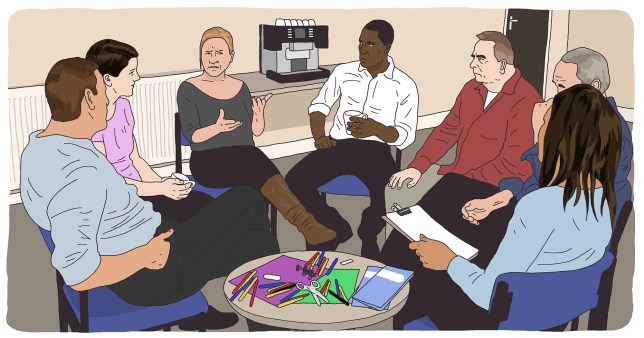Group therapy is a form of psychotherapy that involves one or more therapists working with several people at the same time. This type of therapy is widely available at a variety of locations including private therapeutic practices, hospitals, mental health clinics, and community centers.
Group therapy helps individuals develop communication skills and socialization skills, and allows clients to learn how to express their issues and accept criticism from others. Group therapy allows individuals to develop self-awareness by listening to others with similar issues.
Many group therapies center on a discussion between members. However, group therapy can move beyond talking in a room. Group therapy activities for adults with mental illness can include hiking, cooking, dancing, making art, and more. These types of activities help build group identity, social skills, and can serve as an icebreaker in early group stages.
What Are the Types of Group Therapy?
Different therapists utilize unique types of therapy depending on their background and the needs of the patients. However, most group therapy can be categorized into either one of these types:
Process-Oriented: This type of therapy places primary importance on the experience of being in the group. The way members react and relate to each other and their therapies provides information and creates significant reactions. Ultimately, patients learn how their patterns of behavior can either hurt or benefit them in their daily lives.
Psychoeducational: Here, members learn about various conditions, topics, and life skills. The therapists encourage participation and create group projects and presentations to build specific skills, such as stress management and relapse prevention.
20 Mental Health Group Therapy Activities For Adults
- Make a list of 15 things that you hate. Are you mad at yourself or anyone else?
- Make a list of 30 things that make you feel happy. What could make you happier? Think about things that would make you even happier. Is it a new relationship or something else?
- Make a list of 30 things that make you grateful.
- Draw or write about all the different types of shapes that you prefer over others. What are you creating? What is it that you are trying to build? What pieces of yourself do you put into each of your creations?
- Write about why you’ve decided to go in the direction that you’re going. Are you hoping that something better is going to happen? What would it look like when it does?
- Write about a person you think would make the best president. What qualities do you like in this person? What would this person do that makes you believe that he or she would be the best?
- Write about a place that represents something new you want to try. What are the things that are there that represent your dream? If you could stay forever, what would happen?
- Write about the surprising moments when you realized someone doesn’t know your name. What are these people trying to get from being around you? Why is it a surprise that someone doesn’t know your name? Who is this person, and what are you trying to accomplish with them?
- Draw yourself wearing clothes that are not yours. Make yourself thinner or taller. Make what you’re wearing look like a superhero costume or something wild.
- Write a letter to someone explaining what you love about them and what their effect on you is.
- Draw a picture of your favorite animal. Make the drawing look like a wild, strange creature. What makes it difficult to eat it?
- Draw a picture of you that looks like a money-driven businessperson. What are you selling?
- Draw a picture of you that looks like a family member. Or, draw a picture of a family member that looks like you. What annoys you about your family member?
- Make a list of the or things you like to own. Draw a picture of how you would like to own these things.
- Write about what truly makes you happy, in a non-material and non-physical way.
The Benefits of Group Therapy for Adults with Mental Illness
The benefits of group therapy extend beyond the specific treatment goals of a given group. While they may learn skills like coping with loss or managing stress, they are given additional opportunities. Most importantly, many people do not have an open, safe environment where they feel comfortable sharing about themselves. Group therapy provides this space for them to safely explore their feelings and behaviors.
It also gives them an opportunity to hear from a variety of different people who may be sharing similar conditions with different perspectives. These experiences can help individuals not only find support, but also develop new strategies for how to live and grow. Finally, group therapy activities for adults with mental illness gives patients the chance for old wounds to be understood and ultimately, heal. SEE: How to Become a Mental Health Advocate






